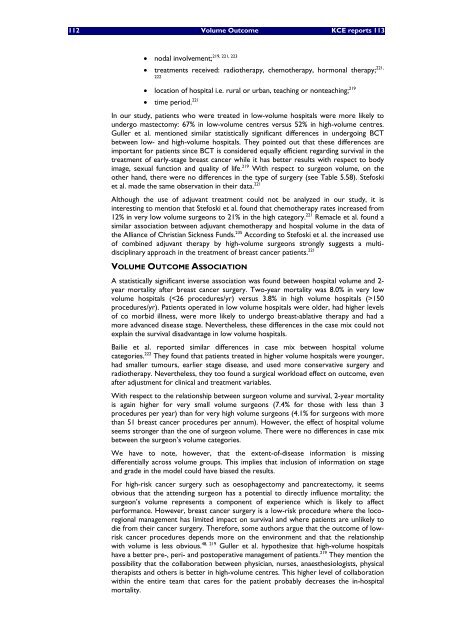Het volume van chirurgische ingrepen en de impact ervan op ... - KCE
Het volume van chirurgische ingrepen en de impact ervan op ... - KCE
Het volume van chirurgische ingrepen en de impact ervan op ... - KCE
You also want an ePaper? Increase the reach of your titles
YUMPU automatically turns print PDFs into web optimized ePapers that Google loves.
112 Volume Outcome <strong>KCE</strong> reports 113<br />
219, 221, 223<br />
• nodal involvem<strong>en</strong>t;<br />
• treatm<strong>en</strong>ts received: radiotherapy, chemotherapy, hormonal therapy; 221,<br />
222<br />
• location of hospital i.e. rural or urban, teaching or nonteaching; 219<br />
• time period. 221<br />
In our study, pati<strong>en</strong>ts who were treated in low-<strong>volume</strong> hospitals were more likely to<br />
un<strong>de</strong>rgo mastectomy: 67% in low-<strong>volume</strong> c<strong>en</strong>tres versus 52% in high-<strong>volume</strong> c<strong>en</strong>tres.<br />
Guller et al. m<strong>en</strong>tioned similar statistically significant differ<strong>en</strong>ces in un<strong>de</strong>rgoing BCT<br />
betwe<strong>en</strong> low- and high-<strong>volume</strong> hospitals. They pointed out that these differ<strong>en</strong>ces are<br />
important for pati<strong>en</strong>ts since BCT is consi<strong>de</strong>red equally effici<strong>en</strong>t regarding survival in the<br />
treatm<strong>en</strong>t of early-stage breast cancer while it has better results with respect to body<br />
image, sexual function and quality of life. 219 With respect to surgeon <strong>volume</strong>, on the<br />
other hand, there were no differ<strong>en</strong>ces in the type of surgery (see Table 5.58). Stefoski<br />
et al. ma<strong>de</strong> the same observation in their data. 221<br />
Although the use of adju<strong>van</strong>t treatm<strong>en</strong>t could not be analyzed in our study, it is<br />
interesting to m<strong>en</strong>tion that Stefoski et al. found that chemotherapy rates increased from<br />
12% in very low <strong>volume</strong> surgeons to 21% in the high category. 221 Remacle et al. found a<br />
similar association betwe<strong>en</strong> adju<strong>van</strong>t chemotherapy and hospital <strong>volume</strong> in the data of<br />
the Alliance of Christian Sickness Funds. 235 According to Stefoski et al. the increased use<br />
of combined adju<strong>van</strong>t therapy by high-<strong>volume</strong> surgeons strongly suggests a multidisciplinary<br />
approach in the treatm<strong>en</strong>t of breast cancer pati<strong>en</strong>ts. 221<br />
VOLUME OUTCOME ASSOCIATION<br />
A statistically significant inverse association was found betwe<strong>en</strong> hospital <strong>volume</strong> and 2year<br />
mortality after breast cancer surgery. Two-year mortality was 8.0% in very low<br />
<strong>volume</strong> hospitals (150<br />
procedures/yr). Pati<strong>en</strong>ts <strong>op</strong>erated in low <strong>volume</strong> hospitals were ol<strong>de</strong>r, had higher levels<br />
of co morbid illness, were more likely to un<strong>de</strong>rgo breast-ablative therapy and had a<br />
more ad<strong>van</strong>ced disease stage. Nevertheless, these differ<strong>en</strong>ces in the case mix could not<br />
explain the survival disad<strong>van</strong>tage in low <strong>volume</strong> hospitals.<br />
Bailie et al. reported similar differ<strong>en</strong>ces in case mix betwe<strong>en</strong> hospital <strong>volume</strong><br />
categories. 222 They found that pati<strong>en</strong>ts treated in higher <strong>volume</strong> hospitals were younger,<br />
had smaller tumours, earlier stage disease, and used more conservative surgery and<br />
radiotherapy. Nevertheless, they too found a surgical workload effect on outcome, ev<strong>en</strong><br />
after adjustm<strong>en</strong>t for clinical and treatm<strong>en</strong>t variables.<br />
With respect to the relationship betwe<strong>en</strong> surgeon <strong>volume</strong> and survival, 2-year mortality<br />
is again higher for very small <strong>volume</strong> surgeons (7.4% for those with less than 3<br />
procedures per year) than for very high <strong>volume</strong> surgeons (4.1% for surgeons with more<br />
than 51 breast cancer procedures per annum). However, the effect of hospital <strong>volume</strong><br />
seems stronger than the one of surgeon <strong>volume</strong>. There were no differ<strong>en</strong>ces in case mix<br />
betwe<strong>en</strong> the surgeon’s <strong>volume</strong> categories.<br />
We have to note, however, that the ext<strong>en</strong>t-of-disease information is missing<br />
differ<strong>en</strong>tially across <strong>volume</strong> groups. This implies that inclusion of information on stage<br />
and gra<strong>de</strong> in the mo<strong>de</strong>l could have biased the results.<br />
For high-risk cancer surgery such as oes<strong>op</strong>hagectomy and pancreatectomy, it seems<br />
obvious that the att<strong>en</strong>ding surgeon has a pot<strong>en</strong>tial to directly influ<strong>en</strong>ce mortality; the<br />
surgeon’s <strong>volume</strong> repres<strong>en</strong>ts a compon<strong>en</strong>t of experi<strong>en</strong>ce which is likely to affect<br />
performance. However, breast cancer surgery is a low-risk procedure where the locoregional<br />
managem<strong>en</strong>t has limited <strong>impact</strong> on survival and where pati<strong>en</strong>ts are unlikely to<br />
die from their cancer surgery. Therefore, some authors argue that the outcome of lowrisk<br />
cancer procedures <strong>de</strong>p<strong>en</strong>ds more on the <strong>en</strong>vironm<strong>en</strong>t and that the relationship<br />
with <strong>volume</strong> is less obvious. 48, 219 Guller et al. hypothesize that high-<strong>volume</strong> hospitals<br />
have a better pre-, peri- and post<strong>op</strong>erative managem<strong>en</strong>t of pati<strong>en</strong>ts. 219 They m<strong>en</strong>tion the<br />
possibility that the collaboration betwe<strong>en</strong> physician, nurses, anaesthesiologists, physical<br />
therapists and others is better in high-<strong>volume</strong> c<strong>en</strong>tres. This higher level of collaboration<br />
within the <strong>en</strong>tire team that cares for the pati<strong>en</strong>t probably <strong>de</strong>creases the in-hospital<br />
mortality.

















